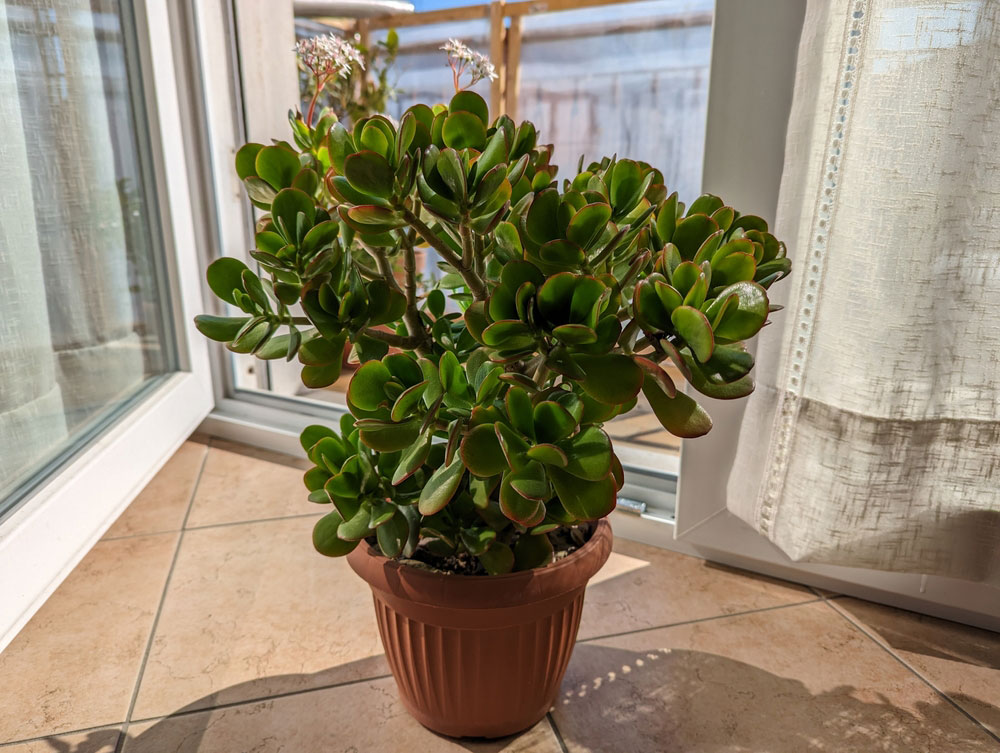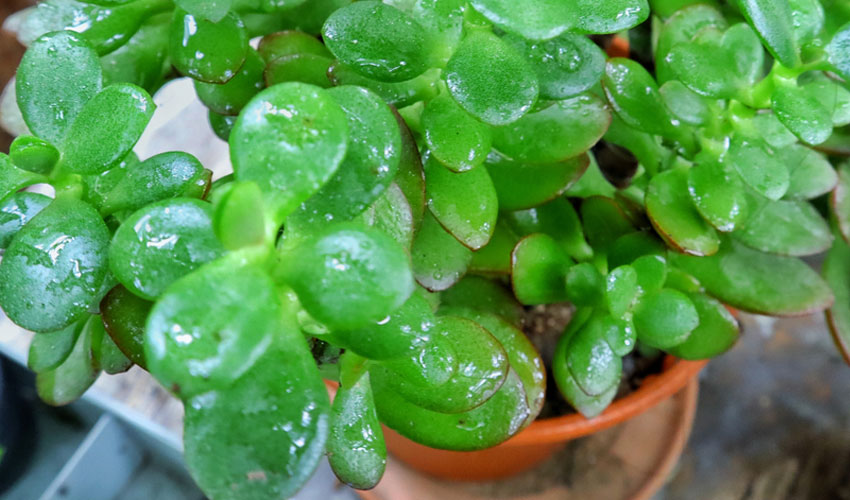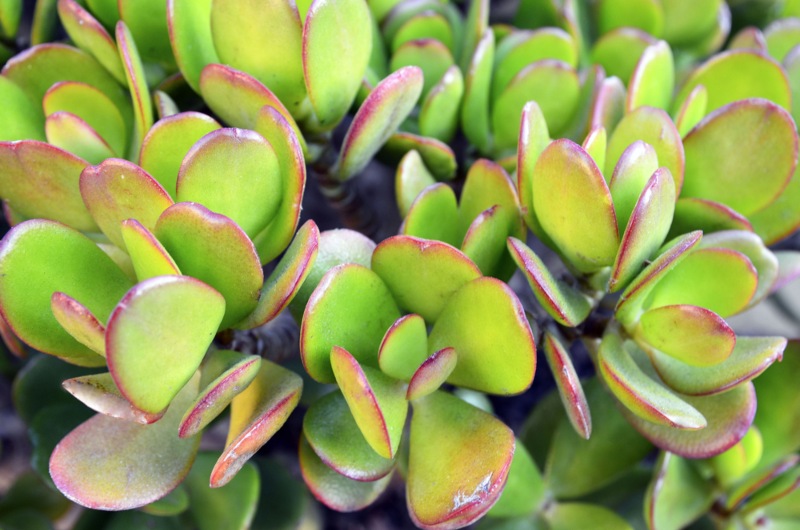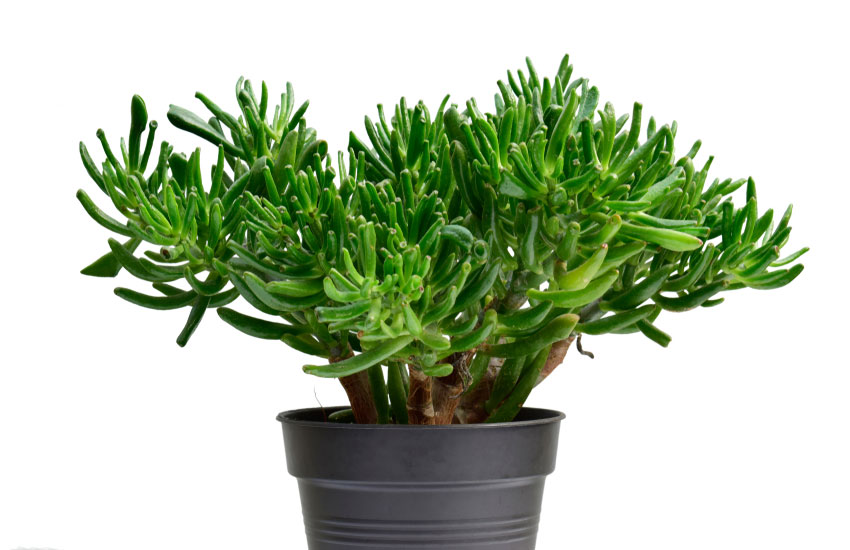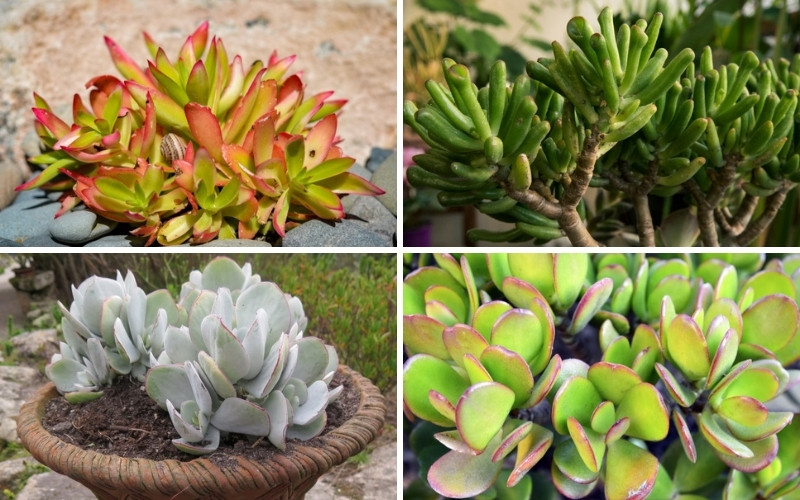
Identified by fleshy green leaves and with over 200 varying species, jade plants have been used as an ornament, a plant grown for decor or aesthetics, and not primarily as a food source.
Throughout history, the jade plant, native to South Africa, has had assorted uses from food to medicinal purposes to being a prosperity-attracting houseplant.
They can be grown indoors or outdoors, and tend to thrive in mild, warm, and dry climates, like hardiness zone 9 and up.
The following list covers different jade plants, characteristics like size and color, and care tips.
Crassula ovata (Money Tree)

Also classified as Crassula argentea Thunb., crassula ovata is the “classic” money tree plant recognizable by its thick ovate green leaves. It can grow up to 6 feet (2 meters) in height. White or pink small star-shaped flowers bloom around late winter and early spring.
Thriving in hardiness zones 10a to 11b, the money tree prefers full sun (minimum of 4–6 hours of direct sunlight to flower) and well-draining soil like sand. Beware of overwatering; let the soil dry before watering again.
Crassula marnieriana (Jade Necklace)

Adorned by beautiful white to pinkish star-shaped flowers in late winter, the Jade Necklace or Crassula marnieriana has a red-rimmed, green leaf-covered stem. The leaves grow in a stacked formation like a necklace. Also known as Chinese Pagoda and Worm Plant, it grows to a height of about 1 foot (30 centimeters).
Grown indoors or outdoors; it prefers full sun in hardiness zones 9a to 10b, with porous well-draining soil, and dry soil before watering.
Crassula picturata (Tiger Jade)
Scientifically known as Crassula picturata or crassula exilis subsp. picturata, the Tiger Jade differs from other jade plants. It has green hairy, thin pointed leaves covered in spots. Flowers blossom during the late summer to early fall.
The Tiger Jade is also a short-lived perennial succulent that prefers full sun and good draining rocky or sandy soil. It flourishes in hardiness zones 9b to 11b. Allow the soil to dry before the next watering.
Crassula sarmentosa comet (Variegated Trailing Jade)

The Variegated Trailing Jade is characterized by its reddish stems that arches and trails down. Attached to the almost 3 feet (90 cm) long stems are ovate yellow serrated leaves with green in the middle and outlined in red when grown in full sun. In the late fall, its pink buds turn to white flowers.
It prefers full sun in hardiness zones 9b to 11b with well-draining soil like chicken grit; excess water will harm the jade. When grown indoors allow 6 hours of direct sunlight.
Crassula coccinea (Red Crassula)

The Red Crassula, also known as Klipblom, is a small succulent shrub with few stems branching from its base. It has flat, oval-shaped overlapping leaves along its stem. Growing up to 16 inches (40 cm) tall, the older dry brown leaves are near the stem’s bottom while the new, bright leaves are towards its end. At the stem’s tip blooms fragrant long, tubular red flowers in midsummer.
Indoors or outdoors, it likes full sun in hardiness zones 9a to 11b, with good draining soil and regular watering.
Crassula sericea (var. hottentotta)
Crassula sericea var. hottentotta or Crassula hottentotta grows up to 6 inches (15 cm) tall. Its grayish-green plump, fleshy leaves are covered in fuzzy appearing rounded papillae. In spring, pretty white flowers bloom.
Indoors or outdoors, it prefers full sun in hardiness zones 10b to 11b, with great draining porous soil. Water properly; water dry soil.
Crassula ovata perforata (String of Buttons)

Known as Necklace Vine, Pagoda Plant, Stacked Crassula, or String of Buttons, Crassula ovata perforata is identified by its stacked fleshy triangular leaves. The leaves grow in opposite pairs reaching heights up to 2 feet (60 cm) tall. String of Buttons grows upright, but as the plant matures the collection of leaves prostrate—lie down. Flowers blossom in the spring.
Caution—leaves will burn in the sun during the hottest summer days. String of Buttons favors absorbent good draining soil in hardiness zones 9a to 11b. Apply small amounts of fertilizer in midspring.
Crassula ovata Hummel’s Sunset (Golden Jade Tree)
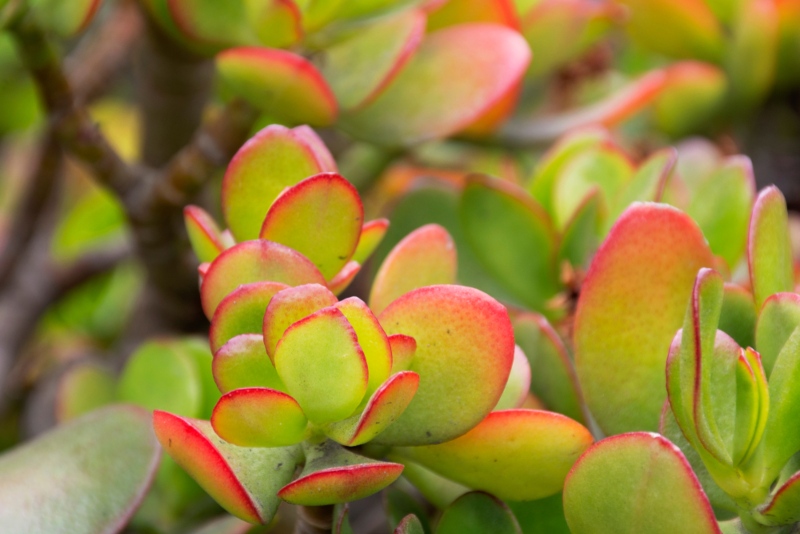
Known for its golden leaves, Crassula ovata Hummel’s Sunset or Golden Jade tree is a shrub that grows up to 3 feet (90 cm) tall. The leaves are green, golden yellow, and sometimes brownish orange. In the late fall to winter, light lavender and white flowers bloom to add to the array of colors.
Indoor or outdoor Golden Jade Tree grows best in full sun in hardiness zones 10a to 11b, with great draining pH-neutral soil. Water only after the soil is parched.
Crassula tomentosa (Woolly Crassula)
Crassula tomentosa or Woolly Crassula is a slow-growing succulent with a similar rose shape. Its leaves are grayish-green and covered with tiny white hairs around the edges. Blooming flowers are white or yellowish, and grow up to 2 feet (60 cm) tall from a tapering flower stem.
Woolly Crassula likes full sun in hardiness zones 9b to 11b, with good draining pervious soil and watering dry soil.
Crassula ovata Crosby’s Compact (Dwarf Jade Plant)
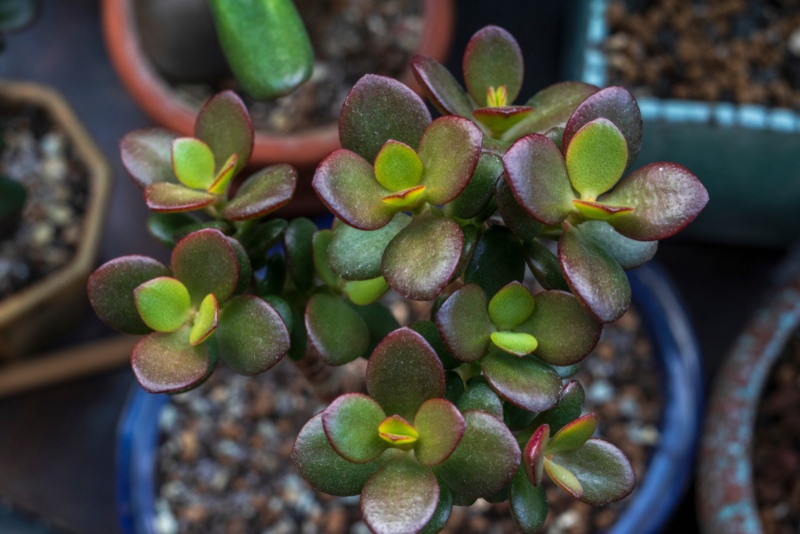
Slow-growing Dwarf Jade Plant grows up to 3 feet (90 centimeters). This shrub-like succulent has thick stems and red outlined green egg-shaped leaves with the thinner portion at the base of the leaf. The new fleshy leaves can be mostly red. White star-shaped flowers bloom in clusters from late fall to winter.
It favors full sun in hardiness zones 10a to 11b, with well-drained pH-neutral soil. Water it regularly in spring through autumn, but water sparingly in the winter to keep leaves plump and healthy.
Crassula ovata gollum (Gollum Jade)
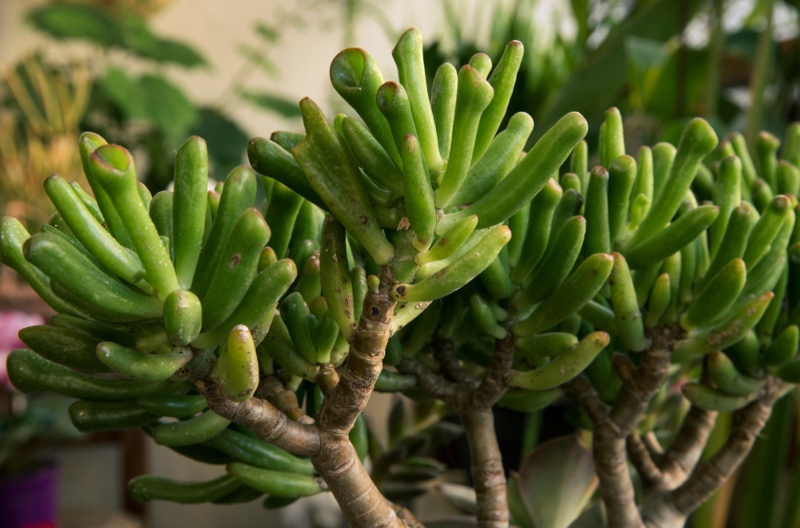
Crassula ovata gollum also known as Gollum Jade, ET’s Fingers, or Finger Jade has a small stature, few branches, and tubular leaves with red tips. It grows up to 3 feet (90 cm) tall and 2 feet (60 cm) wide. White to pinkish-white small star-shaped flowers are produced late fall to early winter.
It prefers full sun in hardiness zones 10a to 11b with porous, neutral pH great drained soil. Watered normally in spring through fall, but limit watering in the winter.
Crassula ovata Pink Beauty (Pink Jade)
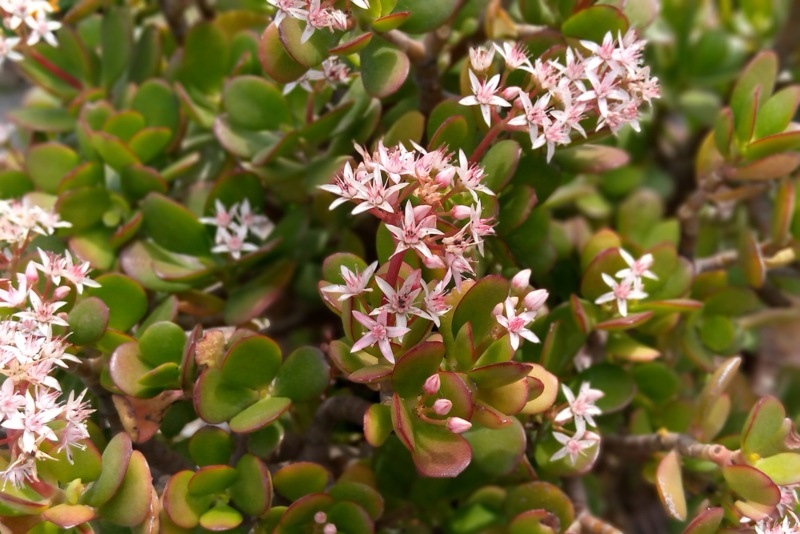
Pink Jade is a branching shrub-like succulent that grows proportionally in height and width up to 5 feet (1.5 meters). With thick stems, glossy green egg-shaped leaves with a narrow point near the base, and red lined edges, it stands out with its fragrant star-shaped flowers that bloom early to midwinter.
It likes partial to full sun, well-drained soil with a neutral pH, and hardiness zones 10a to 11b. Water regularly in spring through autumn, but water enough to keep the leaves from shriveling during the winter.
Kleinia petraea (Weeping Jade)
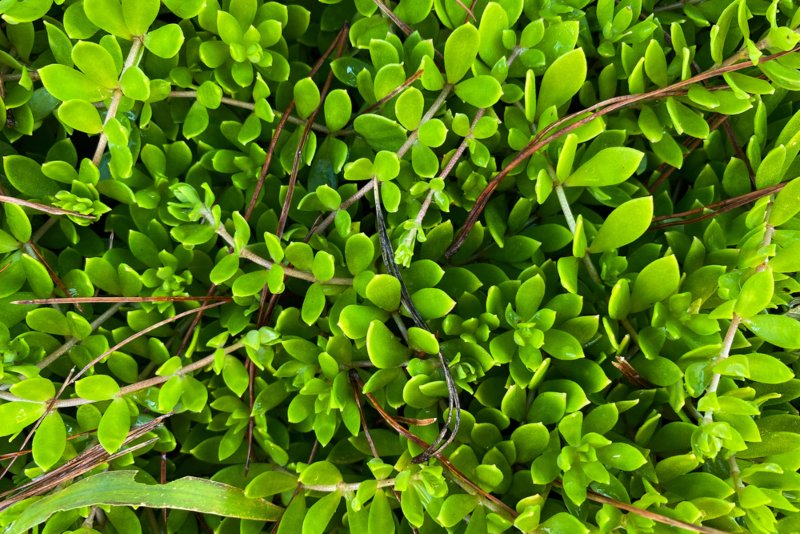
Kleinia petraea is also known as Weeping Jade, Trailing Jade, Vining Jade, and Senecio jacobsenii. Native to Tanzania and Kenya, this jade green fleshy stem and egg-shaped leaf plant grows in extreme drought conditions. In the winter, its leaves are mildly purple, and it blooms bright orange flowers in late fall to winter.
It favors full sun in hardiness zones 10a to 11b, with neutral pH sandy soil and light fertilizer annually. Water less in summer and sparingly during the winter.
Crassula arborescens (Silver Dollar Jade)
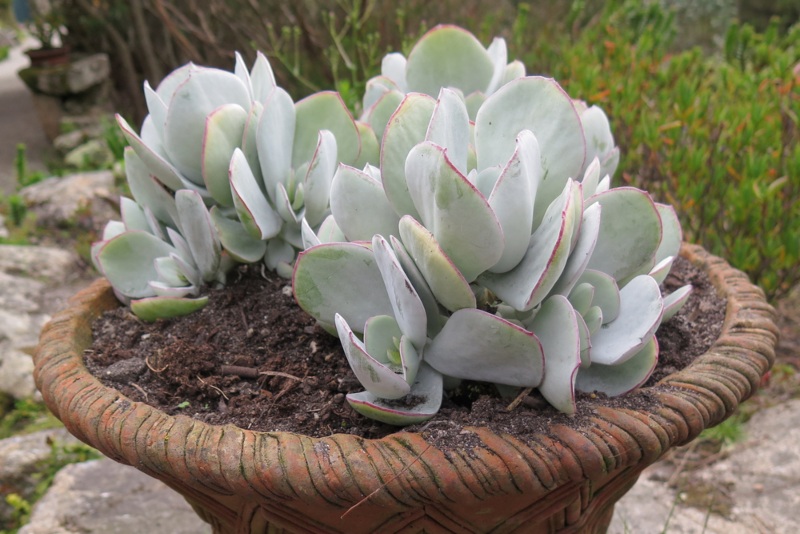
With grayish-silver rounded leaves, Crassula arborescens grows up to 4 feet (1.2 meters) tall. The Silver Dollar Jade has pale red to maroon lined leaves with reddish spots. From spring to summer, it produces star-shaped white to pink flowers.
It likes full sun in hardiness zones 9b to 11b with permeable soil, good drainage, and adequate watering.
Crassula capitella campfire (Campfire Crassula)
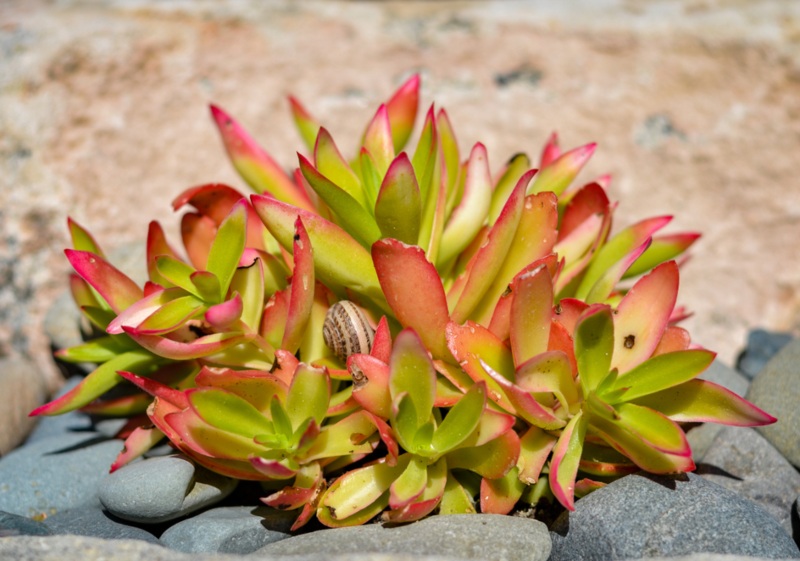
Displaying shades of bright red, yellow, and orange when in full sun—its preference, the fleshy leaves of Campfire Crassula are also shaped like propellers. It doesn’t grow tall—only 6 inches (15 cm)—but it grows up to 3 feet (90 cm) wide. Its white flower clusters bloom in summer.
Campfire Crassula prospers in hardiness zones 9a to 11b, with good draining percolative soil. Water regularly.





